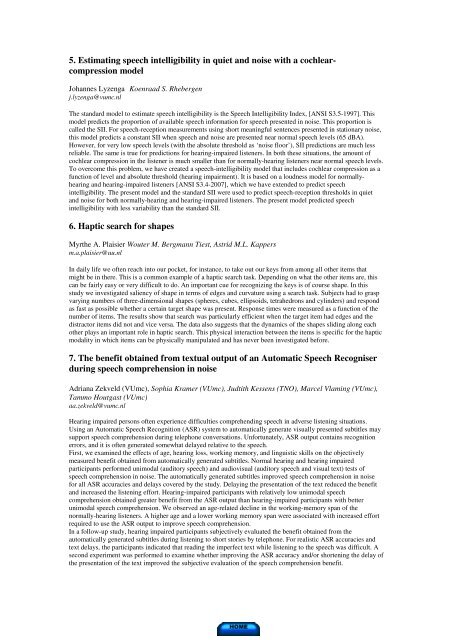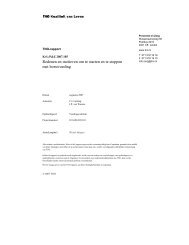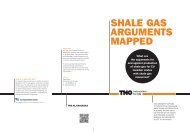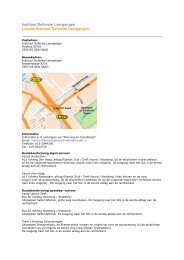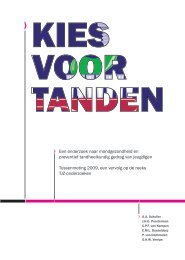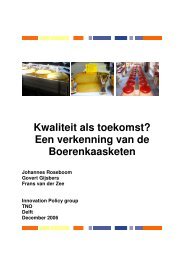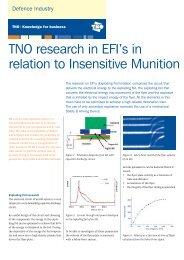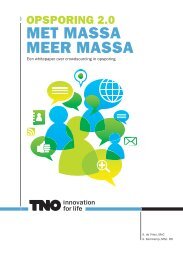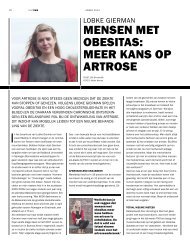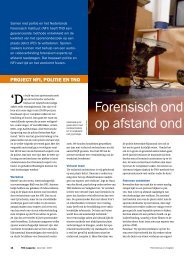Dag van de Perceptie - TNO
Dag van de Perceptie - TNO
Dag van de Perceptie - TNO
Create successful ePaper yourself
Turn your PDF publications into a flip-book with our unique Google optimized e-Paper software.
5. Estimating speech intelligibility in quiet and noise with a cochlearcompression<br />
mo<strong>de</strong>l<br />
Johannes Lyzenga Koenraad S. Rhebergen<br />
j.lyzenga@vumc.nl<br />
The standard mo<strong>de</strong>l to estimate speech intelligibility is the Speech Intelligibility In<strong>de</strong>x, [ANSI S3.5-1997]. This<br />
mo<strong>de</strong>l predicts the proportion of available speech information for speech presented in noise. This proportion is<br />
called the SII. For speech-reception measurements using short meaningful sentences presented in stationary noise,<br />
this mo<strong>de</strong>l predicts a constant SII when speech and noise are presented near normal speech levels (65 dBA).<br />
However, for very low speech levels (with the absolute threshold as ‘noise floor’), SII predictions are much less<br />
reliable. The same is true for predictions for hearing-impaired listeners. In both these situations, the amount of<br />
cochlear compression in the listener is much smaller than for normally-hearing listeners near normal speech levels.<br />
To overcome this problem, we have created a speech-intelligibility mo<strong>de</strong>l that inclu<strong>de</strong>s cochlear compression as a<br />
function of level and absolute threshold (hearing impairment). It is based on a loudness mo<strong>de</strong>l for normallyhearing<br />
and hearing-impaired listeners [ANSI S3.4-2007], which we have exten<strong>de</strong>d to predict speech<br />
intelligibility. The present mo<strong>de</strong>l and the standard SII were used to predict speech-reception thresholds in quiet<br />
and noise for both normally-hearing and hearing-impaired listeners. The present mo<strong>de</strong>l predicted speech<br />
intelligibility with less variability than the standard SII.<br />
6. Haptic search for shapes<br />
Myrthe A. Plaisier Wouter M. Bergmann Tiest, Astrid M.L. Kappers<br />
m.a.plaisier@uu.nl<br />
In daily life we often reach into our pocket, for instance, to take out our keys from among all other items that<br />
might be in there. This is a common example of a haptic search task. Depending on what the other items are, this<br />
can be fairly easy or very difficult to do. An important cue for recognizing the keys is of course shape. In this<br />
study we investigated saliency of shape in terms of edges and curvature using a search task. Subjects had to grasp<br />
varying numbers of three-dimensional shapes (spheres, cubes, ellipsoids, tetrahedrons and cylin<strong>de</strong>rs) and respond<br />
as fast as possible whether a certain target shape was present. Response times were measured as a function of the<br />
number of items. The results show that search was particularly efficient when the target item had edges and the<br />
distractor items did not and vice versa. The data also suggests that the dynamics of the shapes sliding along each<br />
other plays an important role in haptic search. This physical interaction between the items is specific for the haptic<br />
modality in which items can be physically manipulated and has never been investigated before.<br />
7. The benefit obtained from textual output of an Automatic Speech Recogniser<br />
during speech comprehension in noise<br />
Adriana Zekveld (VUmc), Sophia Kramer (VUmc), Judtith Kessens (<strong>TNO</strong>), Marcel Vlaming (VUmc),<br />
Tammo Houtgast (VUmc)<br />
aa.zekveld@vumc.nl<br />
Hearing impaired persons often experience difficulties comprehending speech in adverse listening situations.<br />
Using an Automatic Speech Recognition (ASR) system to automatically generate visually presented subtitles may<br />
support speech comprehension during telephone conversations. Unfortunately, ASR output contains recognition<br />
errors, and it is often generated somewhat <strong>de</strong>layed relative to the speech.<br />
First, we examined the effects of age, hearing loss, working memory, and linguistic skills on the objectively<br />
measured benefit obtained from automatically generated subtitles. Normal hearing and hearing impaired<br />
participants performed unimodal (auditory speech) and audiovisual (auditory speech and visual text) tests of<br />
speech comprehension in noise. The automatically generated subtitles improved speech comprehension in noise<br />
for all ASR accuracies and <strong>de</strong>lays covered by the study. Delaying the presentation of the text reduced the benefit<br />
and increased the listening effort. Hearing-impaired participants with relatively low unimodal speech<br />
comprehension obtained greater benefit from the ASR output than hearing-impaired participants with better<br />
unimodal speech comprehension. We observed an age-related <strong>de</strong>cline in the working-memory span of the<br />
normally-hearing listeners. A higher age and a lower working memory span were associated with increased effort<br />
required to use the ASR output to improve speech comprehension.<br />
In a follow-up study, hearing impaired participants subjectively evaluated the benefit obtained from the<br />
automatically generated subtitles during listening to short stories by telephone. For realistic ASR accuracies and<br />
text <strong>de</strong>lays, the participants indicated that reading the imperfect text while listening to the speech was difficult. A<br />
second experiment was performed to examine whether improving the ASR accuracy and/or shortening the <strong>de</strong>lay of<br />
the presentation of the text improved the subjective evaluation of the speech comprehension benefit.


